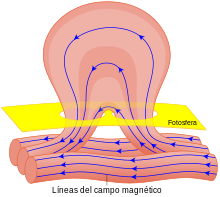Región activa

Una región activa es una región temporal de la atmósfera estelar del Sol caracterizada por un campo magnético fuerte y complejo. A menudo se asocian con manchas solares y suelen ser la fuente de erupciones violentas tales como eyecciones de masa coronal y erupciones solares[1] El número y la ubicación de las regiones activas en el disco solar en un momento dado depende del ciclo solar.[2][3][4][5][6]
Referencias[editar]
- ↑ Zell, Holly (20 de abril de 2015). «Active Regions on the Sun». NASA. Consultado el 18 de julio de 2021.
- ↑ Warren, Harry P.; Winebarger, Amy R.; Brooks, David H. (10 de noviembre de 2012). «A Systematic Survey of High-Temperature Emission in Solar Active Regions». The Astrophysical Journal 759 (2): 141. Bibcode:2012ApJ...759..141W. S2CID 119117669. arXiv:1204.3220. doi:10.1088/0004-637X/759/2/141.
- ↑ Del Zanna, G. (October 2013). «The multi-thermal emission in solar active regions». Astronomy & Astrophysics 558: A73. Bibcode:2013A&A...558A..73D. doi:10.1051/0004-6361/201321653.
- ↑ Basu, Sarbani; Antia, H. M.; Bogart, Richard S. (August 2004). «Ring‐Diagram Analysis of the Structure of Solar Active Regions». The Astrophysical Journal 610 (2): 1157-1168. Bibcode:2004ApJ...610.1157B. doi:10.1086/421843.
- ↑ Hagino, Masaoki; Sakurai, Takashi (25 de octubre de 2004). «Latitude Variation of Helicity in Solar Active Regions». Publications of the Astronomical Society of Japan 56 (5): 831-843. doi:10.1093/pasj/56.5.831.
- ↑ Zhang, Jie; Wang, Yuming; Liu, Yang (10 de noviembre de 2010). «Statistical Properties of Solar Active Regions Obtained from an Automatic Detection System and the Computational Biases». The Astrophysical Journal 723 (2): 1006-1018. Bibcode:2010ApJ...723.1006Z. S2CID 122852367. doi:10.1088/0004-637X/723/2/1006.
